MARIANI’SVirtual
Gourmet
April 21,
2013
NEWSLETTER
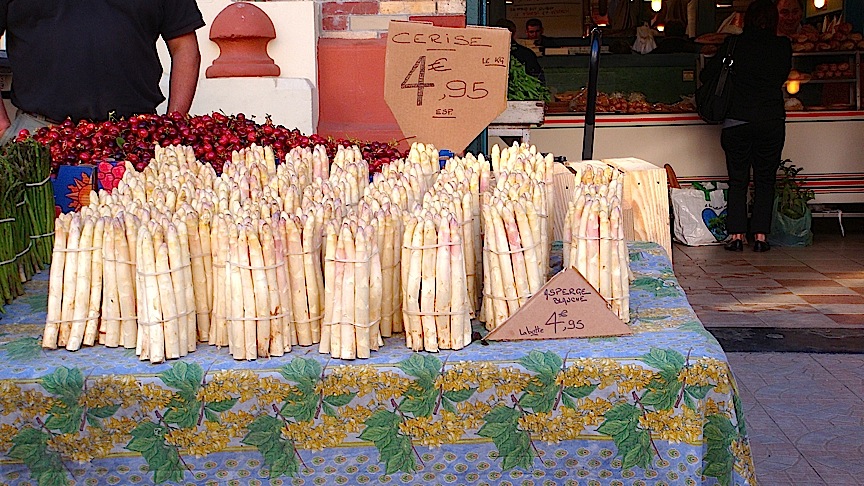
Why We Dine
by John Mariani
Clearwater on the Gulf
bu John Mariani
New York Corner
Bar Boulud
by John Mariani
Notes From the Wine Cellar
The Woman's Touch in Wine
by John Mariani
❖❖❖
WHY WE DINE
by John Mariani

After watching the
horrors the people of Boston and the marathoners
suffered this week at the hands of terrorists
and reading that dozens of Boston restaurants
closed up for security reasons, I was reminded
of what I wrote (originally in The Financial
Times) about the days following the agonies of
911. I
thought it appropriate to reiterate my
sentiments as applicable to the current tragedy
in Boston.
After the
events of 9/11 it was with difficulty that I
tried to reason whether I should dine
out at yet another fine restaurant while New
York was in flames and people were trying so
desperately to cope with what had happened. Then I
read in the newspapers that the day it happened
Sirio Maccioni (below), owner of New York’s
famous restaurant, Le Cirque in midtown, called
then Mayor Rudy Giuliani to ask how he might
help in the crisis. Giuliani said two
words: “Stay open.” That night Le
Cirque served only 65 diners. Two weeks later,
on a Saturday night, the restaurant served
260.
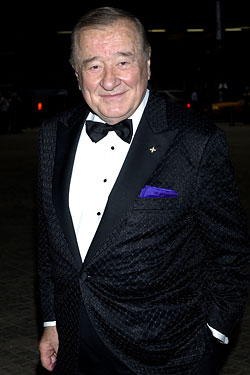 That sentiment has
always carried weight with me, not only because
sitting down to a meal requires the harried mind
to re-focus attention on a basic human
ritual but because it truly helps to
return to a normal need. After hearing of
a tragedy, the appetite may flag, eating may be
the last thing on one’s mind, and dining seems
downright frivolous. But to restore one’s
appetite is to restore one’s strength, as anyone
who has long been sick knows.
That sentiment has
always carried weight with me, not only because
sitting down to a meal requires the harried mind
to re-focus attention on a basic human
ritual but because it truly helps to
return to a normal need. After hearing of
a tragedy, the appetite may flag, eating may be
the last thing on one’s mind, and dining seems
downright frivolous. But to restore one’s
appetite is to restore one’s strength, as anyone
who has long been sick knows.
Six years ago,when I heard
the news that my mother had passed away
overnight, I was tying my tie in a room at the
Crillon Hotel in Paris, ready to go down to
dinner. The news had the obvious effect of
bringing me to my knees, but after commiserating
with my wife, I determined that going down to
dinner would be the very best thing, rather than
stay in the room and weep. We went to
dinner, sure that my mother, who gave me life,
nurtured me as an infant, and imbued me with a
love of good food, a woman who was a great
hostess and loved nothing more than going out to
a fine restaurant, would have insisted I do
so. And so, we ate very well and drank a
very fine wine, toasting my mother as she so
richly deserved.
As a food and travel
writer what I do for a living may seem odd (T.S.
Eliot wrote, “We measure out our lives in
coffee spoons,” but I measure out mine in
morsels of foie gras), but, whenever I think of
it as ephemeral to the great issues of the day,
I am reminded of a scene in the play based on The
Diary of Anne Frank, in which the family,
isolated for months in an attic but still
believing they would soon be out, fantasizes
about the first thing they’d do when they return
to the world outside. Anne says she yearns
to go to a dance. The teenage boy wants to go to
a movie, a western movie! And the adults all
start remembering and dreaming of a wonderful
pastry shop, a good stew, a romantic restaurant
with thick linen and fine wines. None, not
one, declares that the first thing he wants to
do is to change the political structure of
Europe.
This scene made me
realize not only that deprivation takes away
freedoms of movement but also access to the most
wonderful sights, sounds, and tastes of
life--the very things we live for until they are
taken away from us. Every human being on Earth
who has ever gone hungry thinks first of
survival, then of doing something seemingly
superficial--a dance, a western movie, a visit
to a restaurant. For when all goes well,
when the doctor cuts out the cancer, when debt
is retired, when the debris is cleared away,
returning to normal means returning to those
things that make life worth living
During World War II
director Frank Capra made a series of powerful
propaganda films entitled “Why We Fight,” and if
seeing yet again the cheesecake photos (an
interesting turn of phrase) of Rita Hayworth and
Betty Grable in servicemen’s lockers seems
pointedly nostalgic, that does not destroy its
touching allure. “Why We Dine” is as
reasonable a proposition as any other, once we
survive the inevitable rigors and horrors of
life that must be endured. “Animals feed,
man eats,” said Brillat-Savarin, “but only a man
of culture knows how to dine.”
So I carry on extolling and
criticizing our world’s food culture, sometimes
whimsically, sometimes with vitriol. For
the importance of dining out, and drinking good
wine, and falling in love under the spell of
candlelight at the dinner table is to enjoy all
that terrorists--especially those whose
religious fanaticism seeks to deprive people of
all pleasure--would seek to destroy. By
indulging in life’s passions we do much more
than live out our lives. We gain strength
in the belief that they are part of the goodness
of man.
Eat well, be well.
❖❖❖
CLEARWATER
on the GULF
by
John Mariani
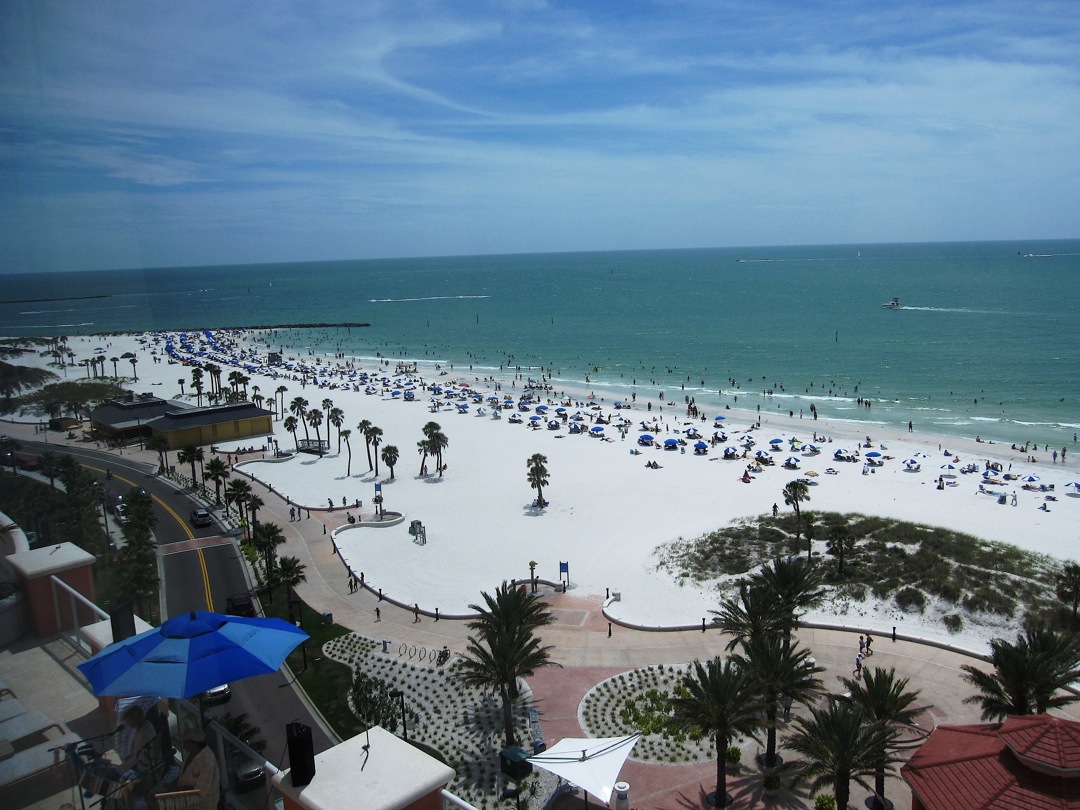
View from the
terrace at the Hyatt Regency Clearwater Beach Resort
and Spa
Not
too long ago Clearwater didn’t look much like it looks
today. Way back it was home to the Tocobaga people and
was as of 1835 an army outpost during the Seminole
Wars. Native Americans are pretty scarce there now.
Its name seems to derive from the
region's many fresh water springs, but it took the
extension of the railroad and a resort hotel named the
Belleview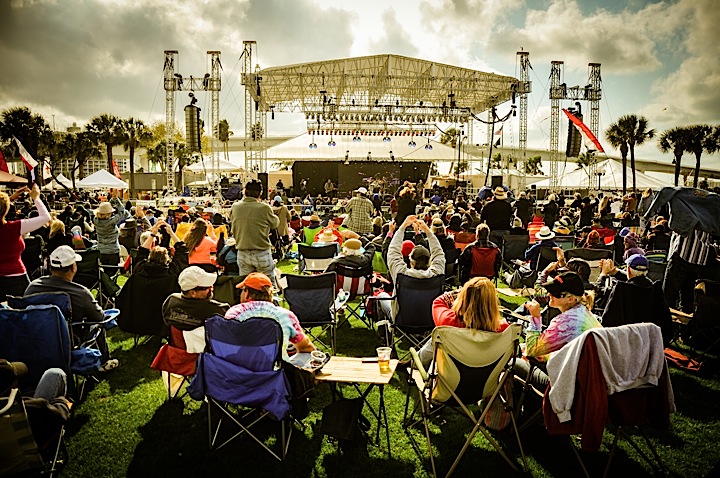 Biltmore,
built in 1897, to give the area a boost. In World
War II it was a military base, but it took a very long
time before the city developed into the resort
community it is today, still a stepsister to St.
Petersburg and Tampa across the bridge, but, as yet,
with little of the big town skyscrapers of those
cities. So,
Clearwater is more laid-back, more flip-flops and
t-shirts, with a good ongoing party atmosphere. I was down there
recently for the rollicking Clearwater Blues Festival,
which even a cold, harsh wind off the Gulf could not
tamper down.
Biltmore,
built in 1897, to give the area a boost. In World
War II it was a military base, but it took a very long
time before the city developed into the resort
community it is today, still a stepsister to St.
Petersburg and Tampa across the bridge, but, as yet,
with little of the big town skyscrapers of those
cities. So,
Clearwater is more laid-back, more flip-flops and
t-shirts, with a good ongoing party atmosphere. I was down there
recently for the rollicking Clearwater Blues Festival,
which even a cold, harsh wind off the Gulf could not
tamper down.
In addition to the big outdoor area
(right) where
the main part of the festival was held, the main
street of town was lined with restaurants and bars
featuring blues artists—the Capitol Beer House is one
of the best--some right out on the streets themselves,
and you’ll get to hear a slew of Buddy Guy, B.B. King,
Stevie Ray Vaughn wannabes with impressive chops. It’s
rightfully called the Blues Walk.
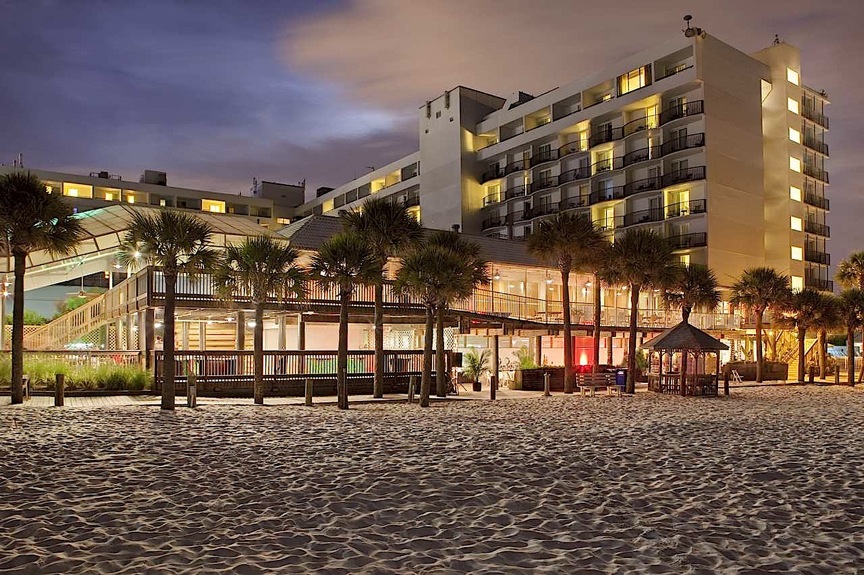 I stayed at the
Hilton
Clearwater Beach Resort (below), set on
the water, and it’s a fine, handsomely decorated place
that gets a good deal of family business in season. I dined
that first night at its restaurant, Reflections, a
casual modern dining room where Chef Scotty Lazlo (below) offered an
extensive tasting menu of first-rate
dishes, starting with a caramelized sea scallop with a
white chocolate potato puree whose slight sweetness
matched the caramelization; peas, tomato marmalade and
a red wine glaze completed this dish. Next up
was a Bahamian conch chowder with plantain chips and a
bracing cilantro-jalapeño cream. More peppery
accents came on with jerk-seasoned shrimp and crab
flatbreads with cilantro-jalapeno
aïoli,
and queso
fresco.
I stayed at the
Hilton
Clearwater Beach Resort (below), set on
the water, and it’s a fine, handsomely decorated place
that gets a good deal of family business in season. I dined
that first night at its restaurant, Reflections, a
casual modern dining room where Chef Scotty Lazlo (below) offered an
extensive tasting menu of first-rate
dishes, starting with a caramelized sea scallop with a
white chocolate potato puree whose slight sweetness
matched the caramelization; peas, tomato marmalade and
a red wine glaze completed this dish. Next up
was a Bahamian conch chowder with plantain chips and a
bracing cilantro-jalapeño cream. More peppery
accents came on with jerk-seasoned shrimp and crab
flatbreads with cilantro-jalapeno
aïoli,
and queso
fresco.
Poached lobster with a smoked
salmon and lump 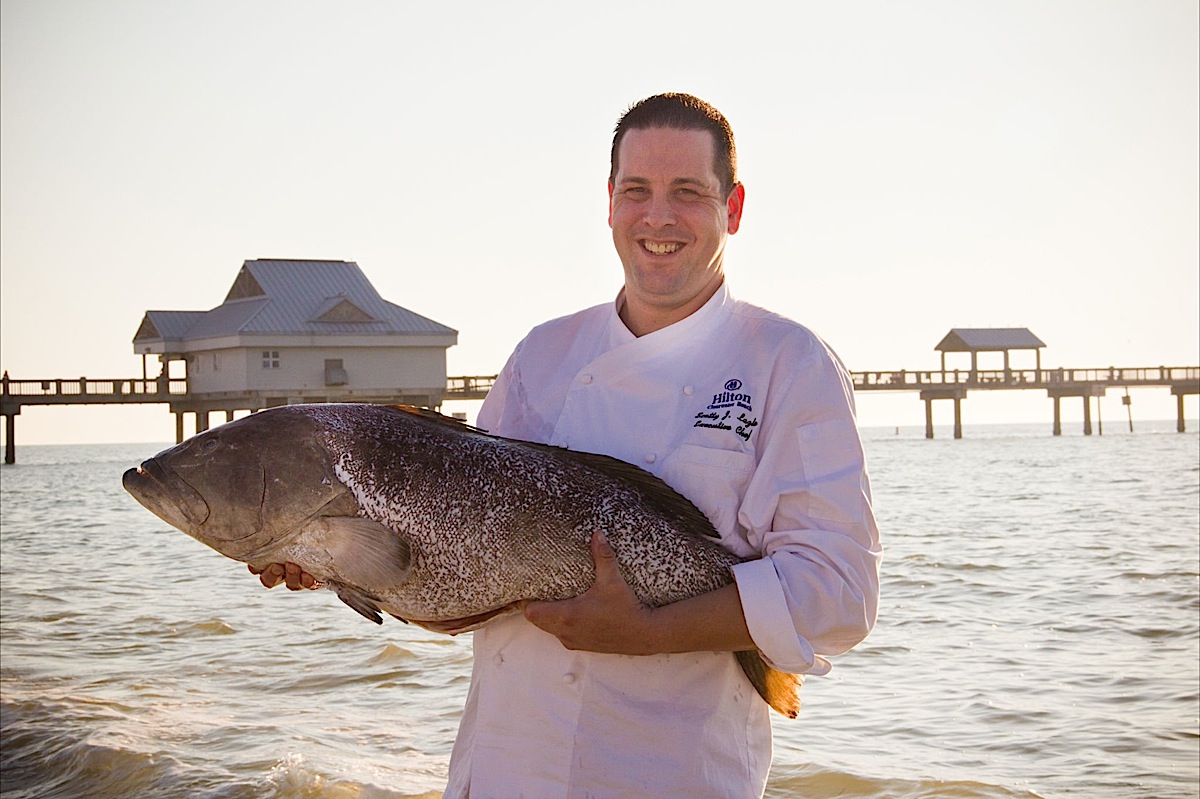 crabmeat salad
arrived on micro-greens with a lovely chive tuile,
orange segments, and mango-caviar vinaigrette—perhaps
too complex a melange for the subtle flavor of the
lobster. Surf and Turf, that venerable American
passion, came as braised Kobe-style short rib
with candied smoked pork belly, duck confit and
Bering Sea King
Crab, sided with
a luscious cauliflower purée and deep red wine
reduction. Grilled grouper with mango salsa took on
extra flavor notes from garlic-laced rice and
broccolini, while a grilled rack of lamb was washed
with a mojito-jalapeño glaze and served with
yellow rice and red beans, a nod towards Florida's
Cuban cuisine connection. For dessert there
was a chocolate raspberry tower with
hazelnut-chocolate mousse, cinnamon whipped cream,
raspberry compote, and chilled Godiva Liqueur. It was a
grand end to a terrific meal rich with the kind of
flavors you truly hope to find in Gulf cookery.
crabmeat salad
arrived on micro-greens with a lovely chive tuile,
orange segments, and mango-caviar vinaigrette—perhaps
too complex a melange for the subtle flavor of the
lobster. Surf and Turf, that venerable American
passion, came as braised Kobe-style short rib
with candied smoked pork belly, duck confit and
Bering Sea King
Crab, sided with
a luscious cauliflower purée and deep red wine
reduction. Grilled grouper with mango salsa took on
extra flavor notes from garlic-laced rice and
broccolini, while a grilled rack of lamb was washed
with a mojito-jalapeño glaze and served with
yellow rice and red beans, a nod towards Florida's
Cuban cuisine connection. For dessert there
was a chocolate raspberry tower with
hazelnut-chocolate mousse, cinnamon whipped cream,
raspberry compote, and chilled Godiva Liqueur. It was a
grand end to a terrific meal rich with the kind of
flavors you truly hope to find in Gulf cookery.
Dinner appetizers
run $9-$18, main courses $18-$31.
I also enjoyed dining at the more
formal—as these things go in Clearwater—dining room Caretta (below) at the
nearby Sandpearl Resort. Well, let’s 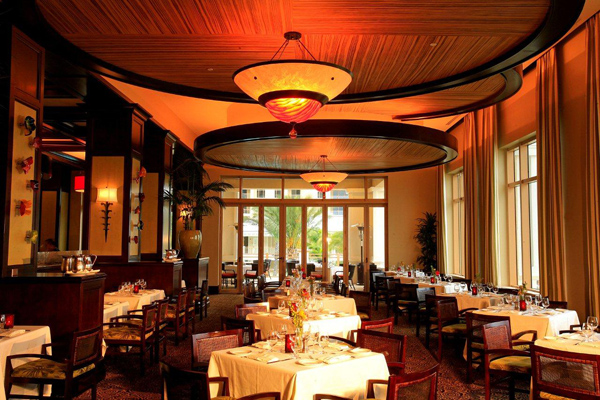 just call it somewhat more posh, with
tall windows overlooking the water—sunsets can get
spectacular around here—curtains, white tablecloths
and dramatic lighting and chandeliers. The service
staff is well-meaning if sometimes lax or,
alternately, intrusive.
just call it somewhat more posh, with
tall windows overlooking the water—sunsets can get
spectacular around here—curtains, white tablecloths
and dramatic lighting and chandeliers. The service
staff is well-meaning if sometimes lax or,
alternately, intrusive.
Named after a sea turtle, Caretta
specializes in seafood, beginning with nicely spicy
tuna rolls with cucumber and assertive sriracha
dressing, a good way to perk up the appetite with a
cocktail or bottle of chilled chardonnay. There is a
selection of sushi and sashimi items, all pristinely
fresh.
The night I visited in late winter,
butternut bisque was on the menu, laced with shards of
duck confit, sweet parsnips, cinnamon and Port, a
truly wonderful melding of flavors. This being
Florida, I could hardly fail to order a hearts of palm
salad with cress, avocado, ruby red grapefruit,
Bermuda Triangle goat’s cheese, and a basil
vinaigrette—easily a good lunch meal in itself and
expressive of all that is good about Florida cuisine.
Staying with that theme, I ordered
Gulf black grouper (nicely cooked) and served with
truffled risotto (overcooked), wild arugula, fennel,
orange and a lush buerre
blanc, while my friend had a 16-ounce Kansas
City strip, at $40 a good price. Desserts were
sumptuous in the Southern style.
The wine list at Caretta is one of
the best selected in the area.
Dinner appetizers run $8-$16, main courses $28-$40.
A much more
casual lunch was had at a local
institution--well, one of a slew of places under the
name Frenchy’s,
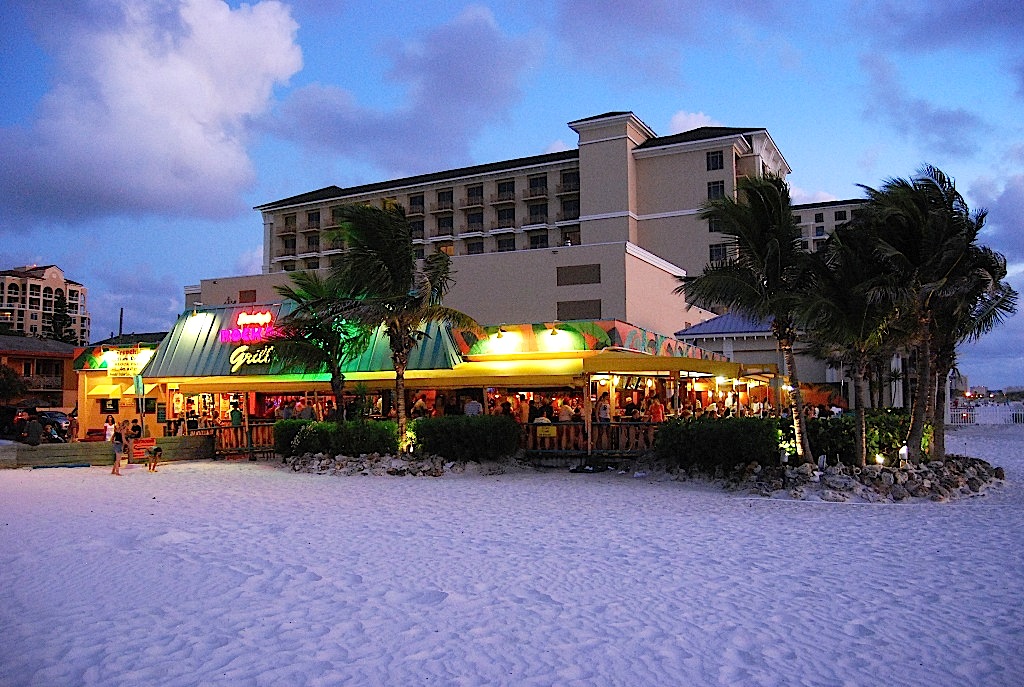 with three more locations.
The first of them opened in 1981; Frenchy’s Rockaway
Grill in Clearwater, where I ate, is almost constantly
jammed from the minute it opens and stays that way
throughout the season.
with three more locations.
The first of them opened in 1981; Frenchy’s Rockaway
Grill in Clearwater, where I ate, is almost constantly
jammed from the minute it opens and stays that way
throughout the season.
It all began with a
Quebecois, Michael Preston, who acquired the nickname
Frenchy’s early on. He moved to Clearwater in high
school and never left, eventually opening the Rockaway
Grill (his second restaurant) here in 1991. It’s
a big, sprawling place—no reservations—and the food
comes out fast via easy-going, sassy waitresses who
know their stuff.
And that stuff is a huge menu of mostly seafood
items, including everything from tuna poke with
macadamia nuts and conch fritters with hot sauce to a
generous fried grouper sandwich with Jamaican jerk
spices and, of course, there;s the requisite fried
shrimp basket. In
season they also have big, fat stone crab claws,
which I gorged on when I was there.
The idea that a place like
Frenchy’s could not possibly turn out so many dishes
with the same aplomb is not unreasonable, except at
the pace and numbers those dishes come out, you can be
assured that the food is as fresh as it can be, and I
found the cooking very good across the board. It’s a
great fun place to be, surrounded by the locals and
the tourists with their families, everyone in shorts
and bathing suits, with good music and happy vibes
throughout. Have
a Landshark beer and go with the flow.
Appetizers run from $2.95-$9.95, main
courses $5.95-$17.95.
 I also had
occasion to re-visit one of my favorite downhome Cuban
restaurants in Florida, the enchantingly scruffy La
Teresita in Tampa on West Columbus Drive. Since I ate
there last, they’ve added a big dining room adjacent
to the café (left),
but the menu is exactly the same, so I happily feasted
at the latter. According
to La Teresita’s website, “The Capdevila Family emigrated from
Cuba to the United States in 1962 on the Freedom
Flights to Miami, Florida. Maximino and Coralia
Capdevila fled Cuba wanting a better life for their
boys after Fidel Castro and communism took over. Even
though they did not know the language and they did not
have any resources, they knew that if they worked hard
they could achieve the American dream.”
I also had
occasion to re-visit one of my favorite downhome Cuban
restaurants in Florida, the enchantingly scruffy La
Teresita in Tampa on West Columbus Drive. Since I ate
there last, they’ve added a big dining room adjacent
to the café (left),
but the menu is exactly the same, so I happily feasted
at the latter. According
to La Teresita’s website, “The Capdevila Family emigrated from
Cuba to the United States in 1962 on the Freedom
Flights to Miami, Florida. Maximino and Coralia
Capdevila fled Cuba wanting a better life for their
boys after Fidel Castro and communism took over. Even
though they did not know the language and they did not
have any resources, they knew that if they worked hard
they could achieve the American dream.”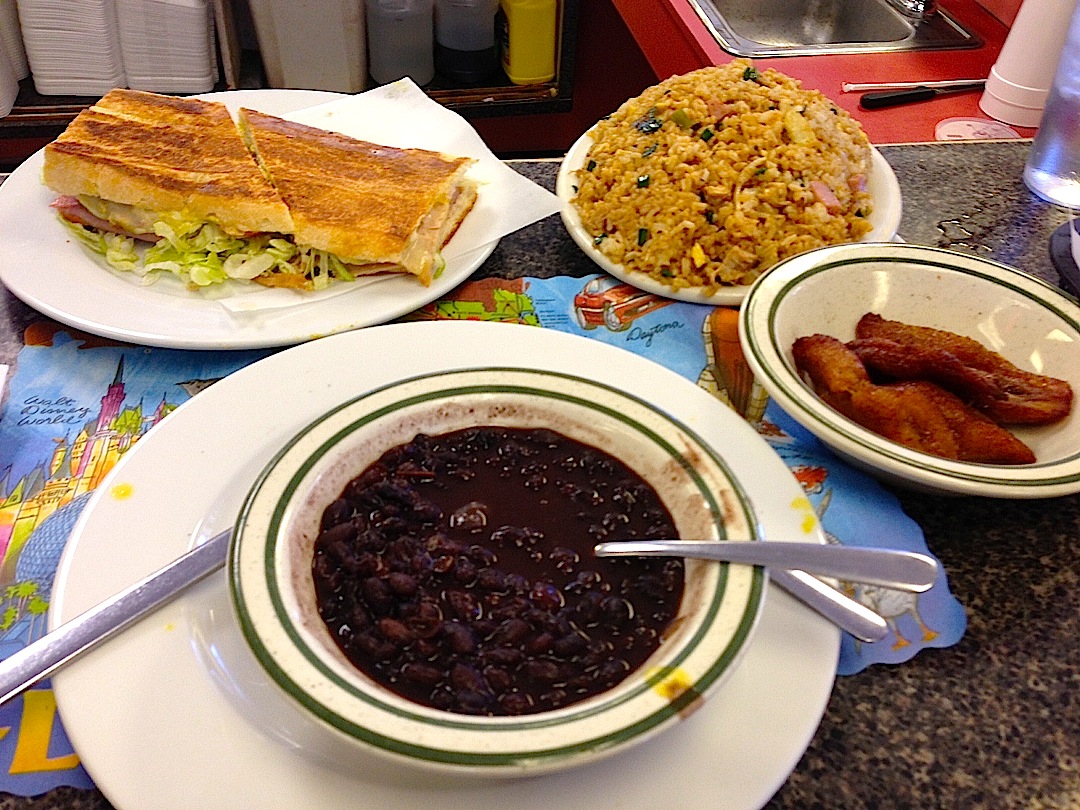
Settling in Tampa, Maximino and
Coralia worked hard for various businesses while their
sons, then at the age of 9 and 7, sold Cuban corn
tamales on their bicycles on the weekends. The family
bought a grocery store they named La Teresita, which
grew into a supermarket, fish and meat market and a
small Coffee & Sandwich Shop, and they
eventually relocated and enlarged it in 1993.
You just belly up to the counter,
which snakes around the brightly lighted room, elbow
to elbow with locals, including Cuban-Americans for
whom everything on the menu here is mother’s
milk. The waitress's Spanish is better than her
English, which is part of the learning curve here.
Food orders are taken, conveyed, you get a beer, and
the food arrives fast.
I love all I’ve tasted here, from
the gutsy black bean soup and the fried plantains to
the Cuban sandwich of ham with mayo and pickles on
crisp French baguettes (right). The menu is vast but go with the
daily specials like puerco
asado on Wednesdays, ropa vieja on
Fridays, and carne
asada on Sundays. And don’t miss the ham croquetas or the
café cubano, as delicious an elixir as can be
found in all of coffee culture.
There’s take out available, so if
you're on the way to the airport, this should be your
on-board meal.
None of this will cost you much,
especially at lunch when ten bucks will get you any
dish on the menu.
by John Mariani
BAR BOULUD
1900
Broadway (across
from Lincoln Center)
212-595-0303
www.danielnyc.com
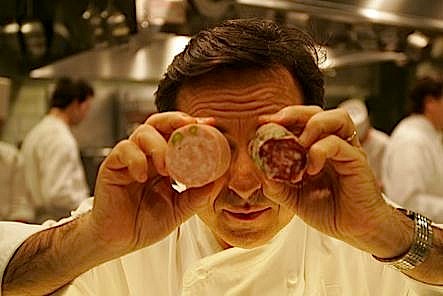 Daniel
Boulud's petit
empire grows larger, with several
restaurants in and out of NYC, including his
flagship Restaurant Daniel, opened in 1993, and
Bar Boulud, opened a decade later across from
Lincoln Center, where he also now has
Épicerie Boulud pastry and food shop and
the Mediterranean-based Boulud Sud. A beautiful
spring day seemed the perfect opportunity for me
to renew my acquaintance with Bar Boulud, which
already has tables set outside and they are
already packed. What better vantage point
for people watching than just a few feet from the
zoom of Broadway and the dazzling light and
architecture of Lincoln Center? Boulud (left) has a
flair for the dramatic.
Daniel
Boulud's petit
empire grows larger, with several
restaurants in and out of NYC, including his
flagship Restaurant Daniel, opened in 1993, and
Bar Boulud, opened a decade later across from
Lincoln Center, where he also now has
Épicerie Boulud pastry and food shop and
the Mediterranean-based Boulud Sud. A beautiful
spring day seemed the perfect opportunity for me
to renew my acquaintance with Bar Boulud, which
already has tables set outside and they are
already packed. What better vantage point
for people watching than just a few feet from the
zoom of Broadway and the dazzling light and
architecture of Lincoln Center? Boulud (left) has a
flair for the dramatic.
I didn't dine outside but
snuggled into a booth, opposite the counter where
they slice the array of superb charcuterie.
Upon opening the restaurant, Boulud had enlisted a
charcuterie master, Sylvain Gasdon, to produce the
exact quality of the kind of artisanal sausages,
pâtés and terrines Boulud ate while
growing up in Lyon, including fromage de
tête, joué de porc, compotée
de lapin, pâté
grand-mère, pâté de
campagne aux foies de volaille, andouille de
Vire, saucisson cuit à l’ail,
pâté en croûte, saucissons
Lyonnais, and much more. You'll find none
better in America.
The cordiality of greeting here
is well known among habitués and visitors
to the Upper West Side, and you will be shown to a
table in the vaulted
100-seat dining room, with its backlighted
gravel wall, wooden booths, tables with textured
mats and Riedel glassware, appended by a
“Tasting Table in the Round” for up to 14 guests
who can enjoy food and wines chosen by a sommelier
in the center.
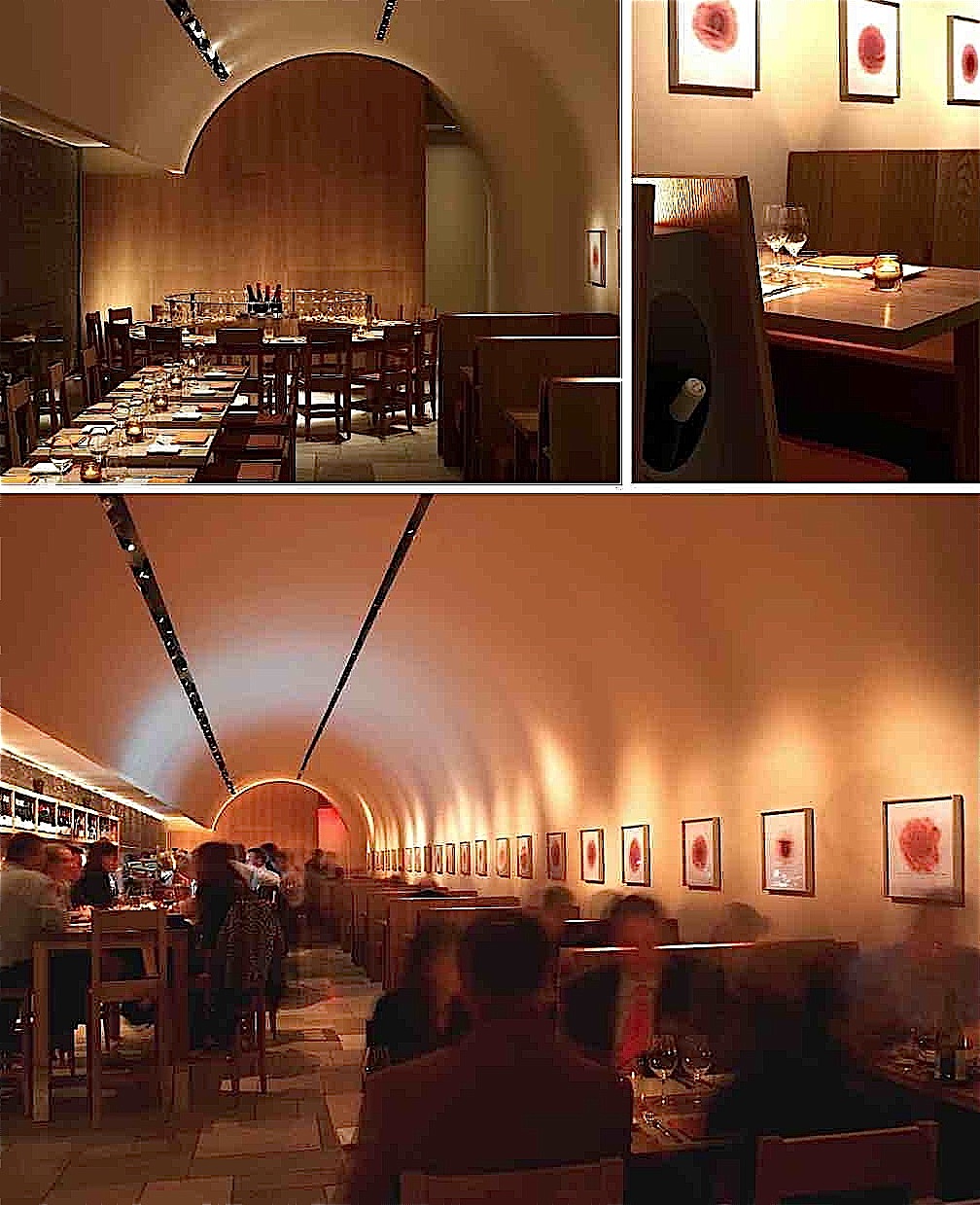 Bar
Boulud’s wine list, more than 500 labels strong,
is dedicated to great French wines of the
Rhône Valley and Burgundy, whose varietals
are the basis of the pickings from
California, Oregon, New Zealand,
Australia, Chile and beyond. There is a good
selection of wines at every price level, so trust
the sommeliers to guide you to something
particularly interesting.
Bar
Boulud’s wine list, more than 500 labels strong,
is dedicated to great French wines of the
Rhône Valley and Burgundy, whose varietals
are the basis of the pickings from
California, Oregon, New Zealand,
Australia, Chile and beyond. There is a good
selection of wines at every price level, so trust
the sommeliers to guide you to something
particularly interesting.
It is very easy and very
tempting simply to gorge on all that wonderful
charcuterie and an array of wines, not to mention
the excellent breads, butters and
cheeses. But this is a bistro too, and I
wouldn’t want you to miss the other dishes,
starting with a generous frisée
lyonnaise of peppery chicory, chicken liver,
poached egg, lardons, and sourdough
bread. At the moment the restaurant is
offering its "Nose to Tail Menu" featuring pork
dishes from Raven & Boar in East Chatham,
NY. It was tough not to order everything on
the menu, from a crêpinette with black
pepper and sage sausage with glazed leeks and pommes purée
to garlic sausage. I ordered the jambon, a
bacon-crusted pork leg of exceptional tenderness,
with a fava bean puree, pearl onion and mint jus. We also
tried the poitrine
de porc, a seared pork belly confit with
creamy polenta and green peppercorn sauce--a
heavy, heavy dish suffused with so much flavor
that just two bites will satisfy you.
A "small board" of charcuterie
was more than enough for two, with about six meats
and condiments on it. We also had luscious wide pappardelle
noodles with roasted baby onions, sweet spring
peas, and creamy cheddar cheese. My friend
chose to go seaward with a sea bass with saffron
fennel confit and an aïoli nage whose sauce was
just the right gloss to bring up the flesh of the
perfectly cooked fish. Don't miss the French
fries either: they are as full of flavor as
everything else, just the right texture, just the
right salt.
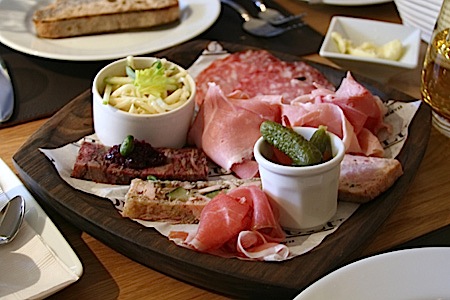 We
somehow still had stomach enough between the two
of us to order one dessert, but Daniel--who was
there in the restaurant in his chef's whites--sent
out three, one more extravagant than the next,
from an "Elixir" of white coffee, chocolate
hazelnut sable, dulce crémeux coffee and
hazelnut ice to "Le Lion" (remember, Boulud is
from Lyon) of passion fruit and yuzu crémeux,
dark chocolate ice cream, vanilla, and
chocolate-passion fruit ice cream, to an
"Ornement," of Meyer lemon foam with layers if
almond sour cherry moëlleux, pistachio, and
lemon ice cream.
We
somehow still had stomach enough between the two
of us to order one dessert, but Daniel--who was
there in the restaurant in his chef's whites--sent
out three, one more extravagant than the next,
from an "Elixir" of white coffee, chocolate
hazelnut sable, dulce crémeux coffee and
hazelnut ice to "Le Lion" (remember, Boulud is
from Lyon) of passion fruit and yuzu crémeux,
dark chocolate ice cream, vanilla, and
chocolate-passion fruit ice cream, to an
"Ornement," of Meyer lemon foam with layers if
almond sour cherry moëlleux, pistachio, and
lemon ice cream.
It is impossible to imagine anyone not enjoying themselves to the hilt at Bar Boulud. It has the same ambiance of a beloved bistro in France, only here you get Broadway in the bargain too.
Bar
Boulud is open for lunch Mon.-Fri., brunch Sat.
& Sun., and dinner nightly. Full bistro menu
including pre-theater and after-theater
dining. Prix fixe pre-theater at $45;
brunch is $32; à la carte appetizers run
$13-$19, main courses $28-$39 fixed price $45.
❖❖❖
The
Woman's Touch in Wine
by John Mariani
 Not
too long ago the image of the restaurant sommelier
fell into two camps: the overbearing French style of
aloof superiority and the overly effusive American
assault with phrases like “killer cabernet” and
“awesome viognier” filling the air--both delivered by
male sommeliers counting on the camaraderie of men at
the tables they served.
Not
too long ago the image of the restaurant sommelier
fell into two camps: the overbearing French style of
aloof superiority and the overly effusive American
assault with phrases like “killer cabernet” and
“awesome viognier” filling the air--both delivered by
male sommeliers counting on the camaraderie of men at
the tables they served.
But over the last few years those defiantly
macho images have been muted by an extraordinary
number of women entering the profession of wine
director in many of the world’s finest restaurants. Even in
Europe, where male dominance of the profession has
traditionally kept women out of the wine cellars,
impeccably trained females are now often the ones
talking to clients and recommending wines with a
softer touch that seems based more on a desire to
please rather than impress.
At Le Meurice in Paris the sommelier is Estelle
Touzet; at Milan’s Principe e Savoie, Alessandra
Veronesi; and in London, at Wolfgang Puck’s CUT
steakhouse, Vanessa Cinti pulls the corks. (All work
for the Dorchester Hotel Group.)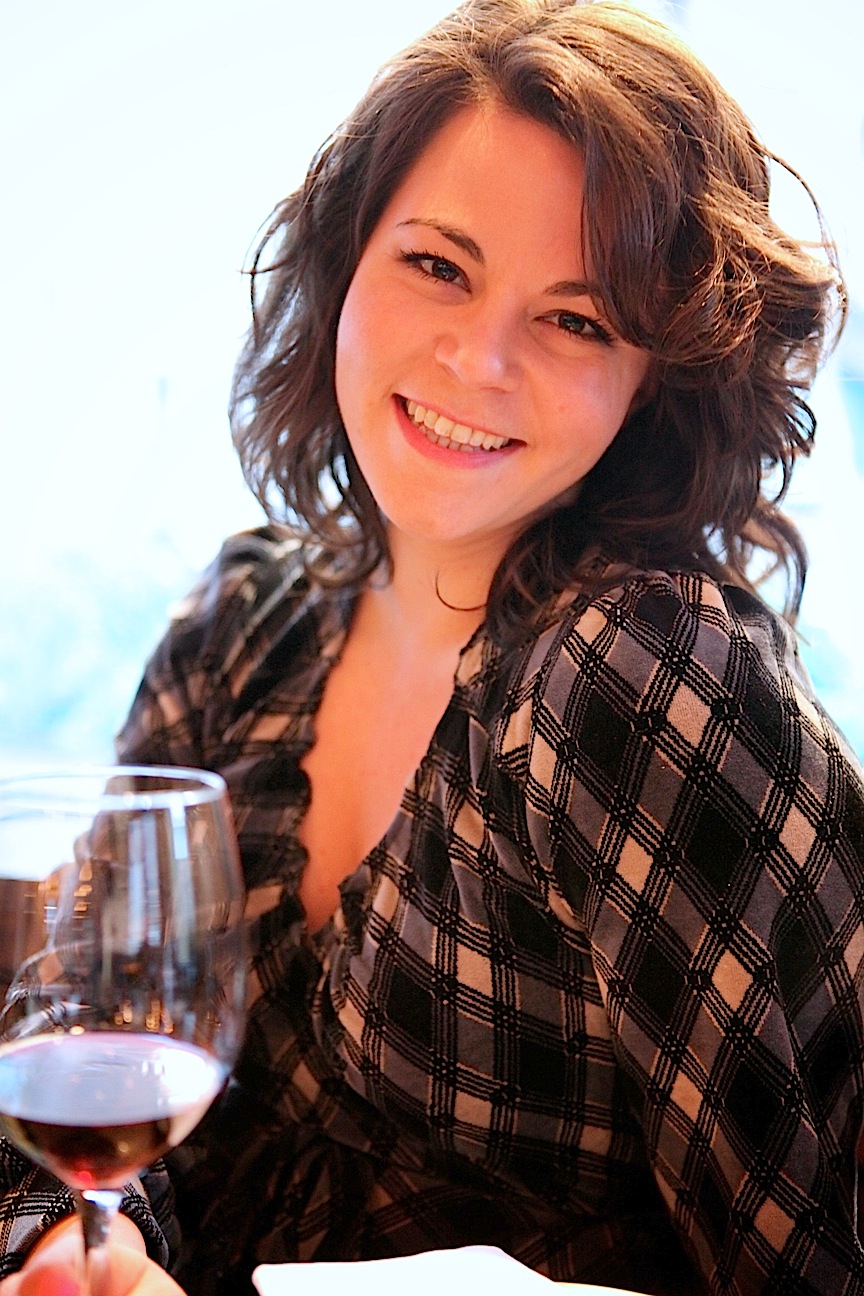
In the U.S. women sommeliers have increased in
amazing numbers. Liz Nicholson (right), beverage
director at New York’s Italian trattoria Maialino,
says she got the job over many male contenders with
longer resumes because, “I think I showed more passion
for Italy than the others. I toured more than 60
wineries in every region of Italy for three months,
and I am just in love with the country’s food, wine,
and culture.”
In the past such a coup was highly unlikely for
a woman. According
to Maeve Pesquera (left),
wine director for the 65 branches of Fleming’s Prime
Steakhouse & Wine Bar in 28 states, “At least 40
percent of 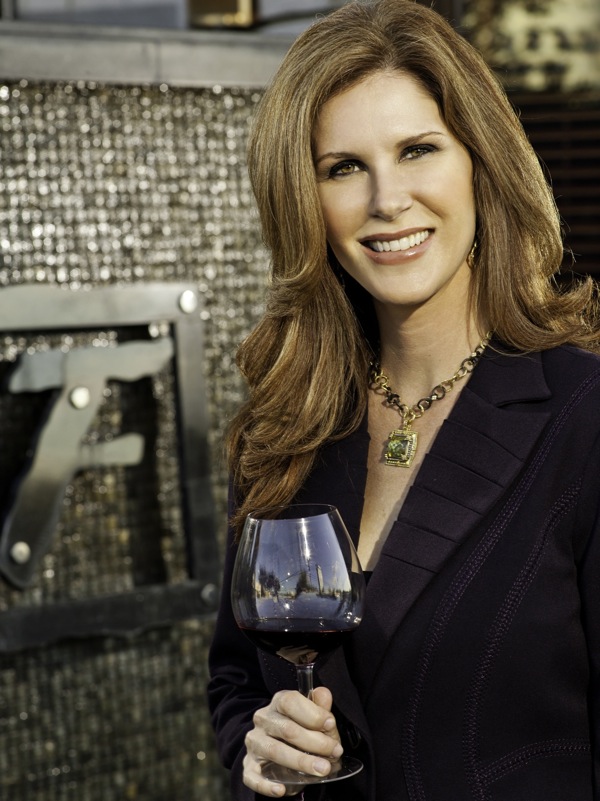 our sommeliers
are now women. When I started out there weren’t many
women in any fine dining job. It’s taken
a generation for us to work through the ranks, and
there was antagonism on both sides of the table
towards women. Many people used to think I was the
hostess.”
our sommeliers
are now women. When I started out there weren’t many
women in any fine dining job. It’s taken
a generation for us to work through the ranks, and
there was antagonism on both sides of the table
towards women. Many people used to think I was the
hostess.”
Pesquera contends that Fleming’s aim was to
break away from the stereotype of the steakhouse where
men came to swig martinis and afterwards smoke cigars.
“At our restaurants you see a lot of women who might
feel otherwise uncomfortable in a traditional
steakhouse,” says Pesquera. “At our restaurants they
dine with their friends, discuss wine and order fine
bottles. And
they are delighted to do so with a woman sommelier.”
At New York’s Gramercy Tavern, Juliette Pope (below), beverage
director since 2004, started as a line cook, became a
waiter, then a “cellar helper” required to clean up
the wine premises, stock the bar, and take care of
inventory. Eventually she took on a bigger role as
beverage director. “At Gramercy Tavern they tend to
hire from within,” she says, “so I just plugged along
and got the  job when my
mentor left. I was primed and energetic and ready to
go.”
job when my
mentor left. I was primed and energetic and ready to
go.”
Sarah Kavanaugh (below), who spent years in both
restaurant kitchens and dining rooms, took over the
position of wine director at New Orleans’ Windsor
Court Grill soon after Hurricane Katrina caused heavy
damage to the wine cellar. “They had no
sommelier after Katrina,” she says. “It was a real
mess, so I was able to built the list the way I wanted
it to be. Now
we have 800 labels and 4,000 bottles.”
She now laughs at the times she
approached a table of men and asked if they wanted to
see the wine list, and they’d say, "`yes, and send
over the sommelier.’”
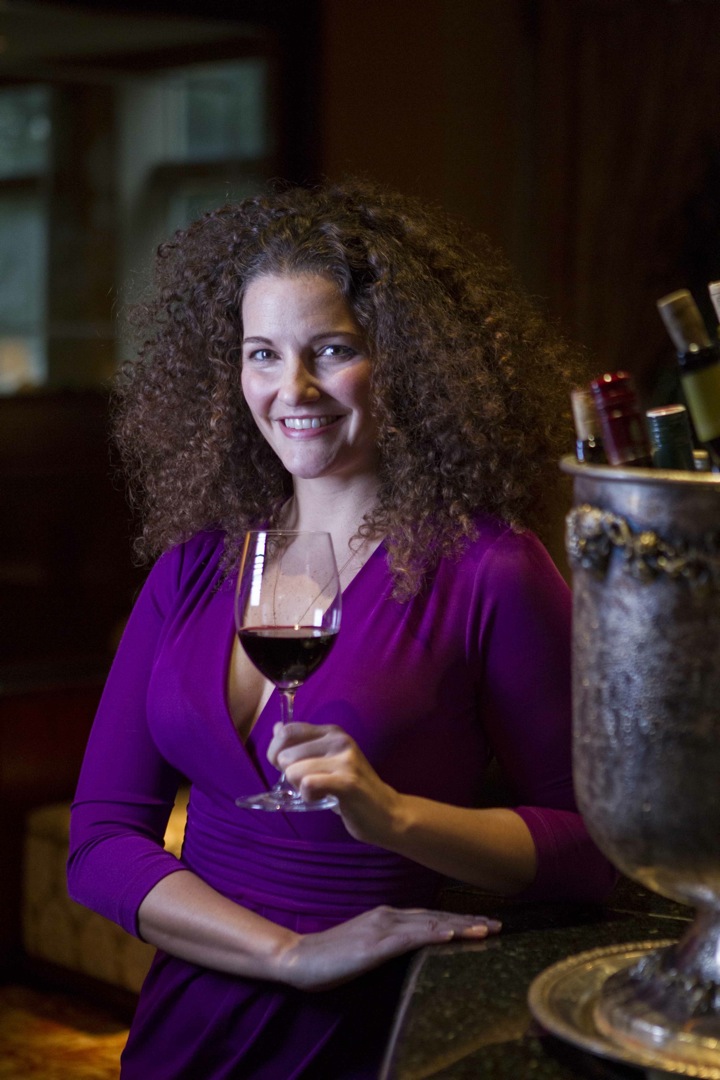 When
asked if women bring a different approach to wine
service, Kavanaugh said, “I think women do have a more
nurturing style, and you have to be able to `read a
table.’ About 60 percent of our guests know what they
want and 40 percent ask for my recommendations. Today
men love seeing a woman sommelier! I have them eating
out of my hand. With ladies, they want to become your
friend and ask for more guidance. I like to talk them
through wine choices. It’s more of a conversation.”
When
asked if women bring a different approach to wine
service, Kavanaugh said, “I think women do have a more
nurturing style, and you have to be able to `read a
table.’ About 60 percent of our guests know what they
want and 40 percent ask for my recommendations. Today
men love seeing a woman sommelier! I have them eating
out of my hand. With ladies, they want to become your
friend and ask for more guidance. I like to talk them
through wine choices. It’s more of a conversation.”
Liz Nicholson agrees, saying, “It is in a
woman’s nature to be very hospitable. If anything,
women sommeliers have really helped remove being so uptight
about ordering wine. It comes from a place in our
heart based on the way we were raised. Our supreme
goal is to get people what they want and make them
happy. Women
bring that spirit.”

In its April issue, Southern Living Magazine features an article on
"The South's Tastiest Towns," spotlighting "the new Pêche Seafood Grill
in New Orleans, for celebrating and elevating traditional Louisiana foods
like gumbo, crawfish pie, red drum, and muffalettas." The restaurant,
however, is still weeks away from opening.
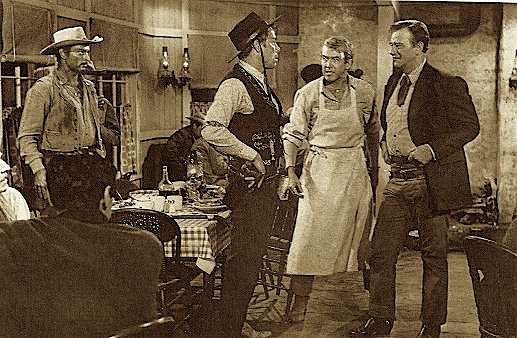
At The Cajun Experience in Leesburg, VA, customers
who bring a gun can get 10% off on "Open Carry
Wednesday." Restaurant owner Brian Crosswhite told
ABC7, "Why can't I promote my business as a
gun-friendly place that people come in and are
law-abiding citizens who chose to participate in
the Second Amendment."
❖❖❖
Any of John Mariani's
books below may be ordered from amazon.com.
 |
My latest book, which just won the prize for best book from International Gourmand, written with Jim Heimann and Steven Heller, Menu Design in America, 1850-1985 (Taschen Books), has just appeared, with nearly 1,000 beautiful, historic, hilarious, sometimes shocking menus dating back to before the Civil War and going through the Gilded Age, the Jazz Age, the Depression, the nightclub era of the 1930s and 1940s, the Space Age era, and the age when menus were a form of advertising in innovative explosions of color and modern design. The book is a chronicle of changing tastes and mores and says as much about America as about its food and drink.
“Luxuriating vicariously in the pleasures of this book. . . you can’t help but become hungry. . .for the food of course, but also for something more: the bygone days of our country’s splendidly rich and complex past. Epicureans of both good food and artful design will do well to make it their coffee table’s main course.”—Chip Kidd, Wall Street Journal.
“[The menus] reflect the amazing craftsmanship that many restaurants applied to their bills of fare, and suggest that today’s restaurateurs could learn a lot from their predecessors.”—Rebecca Marx, The Village Voice. |
"Eating Italian will never be the same after reading John Mariani's entertaining and savory gastronomical history of the cuisine of Italy and how it won over appetites worldwide. . . . This book is such a tasteful narrative that it will literally make you hungry for Italian food and arouse your appetite for gastronomical history."--Don Oldenburg, USA Today. "Italian
restaurants--some good, some glitzy--far
outnumber their French rivals. Many of
these establishments are zestfully described
in How Italian Food Conquered the World, an
entertaining and fact-filled chronicle by
food-and-wine correspondent John F.
Mariani."--Aram Bakshian Jr., Wall Street
Journal.
"Equal parts
history, sociology, gastronomy, and just
plain fun, How Italian Food Conquered the
World tells the captivating and delicious
story of the (let's face it) everybody's
favorite cuisine with clarity, verve and
more than one surprise."--Colman Andrews,
editorial director of The Daily
Meal.com. "A fantastic and fascinating
read, covering everything from the influence
of Venice's spice trade to the impact of
Italian immigrants in America and the
evolution of alta cucina. This book will
serve as a terrific resource to anyone
interested in the real story of Italian
food."--Mary Ann Esposito, host of PBS-TV's
Ciao
Italia. "John Mariani has written the
definitive history of how Italians won their
way into our hearts, minds, and
stomachs. It's a story of pleasure over
pomp and taste over technique."--Danny Meyer,
owner of NYC restaurants Union Square Cafe,
Gotham Bar & Grill, The Modern, and
Maialino.
|
 |
 |
 |
 |
 |
 |
 |
 |
 Everett Potter's Travel Report:
Everett Potter's Travel Report: 
 Eating Las Vegas
is the new on-line site for Virtual Gourmet
contributor John A. Curtas., who since 1995
has been commenting on the Las Vegas food
scene and reviewing restaurants for Nevada
Public Radio. He is also the
restaurant critic for KLAS TV, Channel 8 in
Las Vegas, and his past reviews can be
accessed at KNPR.org.
Click on the logo below to go directly to
his site.
Eating Las Vegas
is the new on-line site for Virtual Gourmet
contributor John A. Curtas., who since 1995
has been commenting on the Las Vegas food
scene and reviewing restaurants for Nevada
Public Radio. He is also the
restaurant critic for KLAS TV, Channel 8 in
Las Vegas, and his past reviews can be
accessed at KNPR.org.
Click on the logo below to go directly to
his site.

Tennis Resorts Online: A Critical Guide to the World's Best Tennis Resorts and Tennis Camps, published by ROGER COX, who has spent more than two decades writing about tennis travel, including a 17-year stretch for Tennis magazine. He has also written for Arthur Frommer's Budget Travel, New York Magazine, Travel & Leisure, Esquire, Money, USTA Magazine, Men's Journal, and The Robb Report. He has authored two books-The World's Best Tennis Vacations (Stephen Greene Press/Viking Penguin, 1990) and The Best Places to Stay in the Rockies (Houghton Mifflin, 1992 & 1994), and the Melbourne (Australia) chapter to the Wall Street Journal Business Guide to Cities of the Pacific Rim (Fodor's Travel Guides, 1991).


MARIANI'S VIRTUAL GOURMET
NEWSLETTER is published weekly. Editor/Publisher: John
Mariani.
Contributing Writers: Christopher Mariani, Robert Mariani,
John A. Curtas, Edward Brivio, Mort Hochstein,
Suzanne Wright, and Brian Freedman. Contributing
Photographers: Galina Stepanoff-Dargery,
Bobby Pirillo. Technical Advisor: Gerry McLoughlin.
© copyright John Mariani 2013
